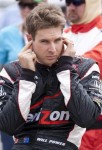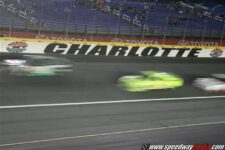“It’s incredible that no more than just one driver was hurt,” Mario Andretti said Monday on CNN. “Dan’s situation was a very freakish thing where his car flew right up into the catch fencing. The track is very well equipped, it is one of a few tracks to have SAFER walls all the way around, but he just missed the top of it. It was so unfortunate.”
The IZOD IndyCar Series veteran added that there needs to be nothing done. This coming after an accident that happened at Las Vegas Motor Speedway sending three cars airborne, taking out another 12 cars and killing Dan Wheldon.
However, even before the race started, there was concerns from the drivers about the type of racing that was about to take place.
Will Power, who was one of the cars that went airborne, told his father Bob before the race that somebody was going to get killed out there, as according to Australia’s Daily Telegraph.
“All it takes is one mistake by one driver and it could be huge consequences,” Ryan Hunter-Reay had said before the race. “This should be a nail-biter for the fans, and it’s going to be insane for the drivers.
“To be in the middle of the field might not be the best situation early on,” Paul Tracy had added. “There is the potential for a big wreck, so we hope to stay out of that.”
IndyCar’s website had it predicted it would be a wild race with James Hinchcliffe saying in a video that, “The hot spot is every inch of the 1.5 miles. It’s such a grippy track. A place like Kentucky there are bumps and the cars move around a little bit. Here, they aren’t doing that and we are race car drivers and will take every inch that we are given and you have just eliminated the entire margin. The racing is so close and when something goes around it can really go wrong.”
As predicted, the race was crazy early on and as a result, the unthinkable happened. Two wheels touched between cars, which sent Hinchcliffe flying. Drivers behind tried to react and avoid harm but couldn’t, making contact, sending Wheldon and Power both flying from the bottom of the track to the outside wall. Wheldon’s car missed the outside retaining wall, as the top of the cockpit with the driver is exposed hit the catchfence. As a result, Wheldon was pronounced dead two hours later due to head injuries.
The drivers knew right away that it was ugly and what had been hinted of before the race just driving through the debris.
“It was just a chain reaction, and everybody slowed down, got bunched up again and there were more crashes that started behind it,” Scott Dixon told Sports Illustrated. “It’s unfortunate because everybody knew it was going to happen. You could see it from Lap 2 people were driving nuts. It doesn’t even matter the speeds – you can’t touch with these cars.”
“It was like a movie scene which they try to make as gnarly as possible,” Danica Patrick, who was running her last IndyCar race before moving to NASCAR, said. “It was debris everywhere across the whole track. You could smell the smoke. You could see the billowing smoke on the back straight from the car. There was a chunk of fire that we were driving around. You could see cars scattered.”
This wasn’t a surprise at all to anybody as the warnings were there before the race even started. Many drivers had warned series officials, including this year’s champion Dario Franchitti.
“You know I love hard racing, but that to me is not really what it’s about,” he said after the accident. “I said before we even tested here that this was not a suitable track for us, and we’ve seen it today. You can’t get away from anybody. There’s no way to differentiate yourself as a car or a driver. People get frustrated and go four-wide and you saw what happened.”
For NASCAR, the track is fine as if they rub fenders, it’s just known as minor contact and everybody can continue. Though for IndyCar, there are no fenders there so they rub wheels. The rubbing of wheels creates a dangerous situation as the touch sends another car wrecking, and probably after taking flight.
As Tracy noted on CNN, “The IndyCars now, they spec the cars to where they want cars to run a bit more in the pack like NASCAR, and these cars are not designed to run and bang wheels with each other at 220mph. Our wheels are exposed, NASCAR are closed body cars like street cars, so once you have two cars touch each other, you don’t have any control of what can happen.”
The current aerodynamics brings forth the pack racing and with speeds exceeding 220 mph, drivers don’t have the time to react. If they do react, due to being in a freight train format, the person behind them may not. As many have repeated, the increased field size of Las Vegas from a normal field under 20 cars to 34 cars increased the risk.
If IndyCar wants to keep with the current aerodynamics, the oval pack racing that is seen needs to go. However, this doesn’t mean to remove all oval tracks, like Iowa and Indy, should not be removed as they’re not as fast and you see drivers have the ability to get spread out.
The dismissal of oval tracks is just a start, though. Wheldon’s death was more due to the open cockpit contact with the catch fence.
One suggestion is closed cockpits as Ryan Briscoe tweeted, “I’d like to see future IndyCar/Open Wheelers with closed cockpits one day, like modern Le Mans LMP1 cars have today.” The only problem would be debris and dirt making it hard to see, however a simple solution of tear-offs could solve that.
The other solution is maybe to look at changing the catch fence design.
“Even with the new technologies that have come about in the last 10 years, nothing has changed when it comes to the catch fencing,”Tracy explained to Sirius Speedway. “We saw it with Carl Edwards at Talladega, and we saw it again Sunday with Dan. When cars get into the fencing, it acts like a spider web. It grabs them and tears them to pieces.”
Whether you take suggestions given or others come about, change is needed. Dan Wheldon dying along with Will Power suffering back pain, J.R. Hildebrand suffering from a severely-bruised sternum and Pippa Mann with a severely burned finger is too much. A repeat of what happened would be horrendous as images and descriptions of Sunday already go too far.
“It was like driving through a war zone,” Briscoe said after the wreck. “We all predicted something like this would happen.”
That prediction factor is what haunts IndyCar racing now because as more people learn the details, they seem to find themselves blaming IndyCar’s head brass. For them instead of IndyCar CEO Randy Bernard taking care of a problem, they see an image of him liking the style of racing.
“I was watching practice and it was unbelievable,” Bernard told Sports Illustrated after practice. “Three wide at more than 220mph.”
Once again, practice on Thursday showed more warnings, yet nothing done. That’s how the situation is read. That’s why you may see big names leave IndyCar.
“I’ve warned him to give up for awhile,” F1 Champion Jody Shecter said of son Tomas. “Hopefully this will knock some sense into him and realize there is more to life. It really isn’t worth it.”
Tracy says he’s reconsidering after seeing Wheldon die before his eyes and after hearing concerns from his family.
Power, who broke his back at Infinion Raceway, a road course, in 2009 “has taken time off to collect his thoughts and reconsider his future” as per Australia’s Daily Telegraph. His father, Bob, said he’d be okay with a change.
“It wouldn’t worry me if he walked away and tried something else,” Bob Power said. “I would like him to have a go at Formula 1 or something like that, because it is a hell of a lot safer than running around ovals in IndyCar. I would much rather him run on road circuits because ovals are a worry.”
The concern was there from the start and are still there. Easily people are going to blame the head brass as stated, but there’s of course another side to the coin.
In 2000, the drivers chose to boycott the race at Texas Motor Speedway due to concerns after feeling dizziness in practice.
Many could question why they didn’t choose to boycott this race. Was it due to fears of what might have been said if they did? If so, does that overcome the fear of risk and safety? Easily nope, so many should also look to the drivers as to why they still ran the race.
Looking back at Las Vegas no matter the opinion of what happened and how, only hope of change for the future can help us in looking back at what happened.
“This is a huge tragedy for IndyCar but I hope that out of the tragedy comes some good in terms of improving more in safety,” Tracy said. “Like when Greg Moore died and Dale Earnhardt Sr., and now Dan Wheldon. The innovations that came out from that in terms of improving driver safety need to be kicked up a notch. We hope that is what will happen.”








